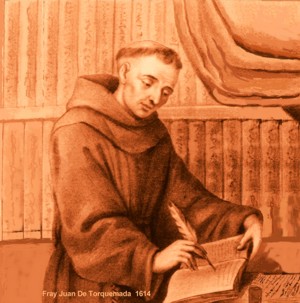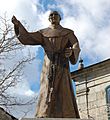Fray Juan de Torquemada facts for kids
Quick facts for kids Juan de Torquemada |
|
|---|---|

Fray Juan de Torquemada, from Lucas Alamán's Historia de la República Mexicana (1860)
|
|
| Religion | Roman Catholic |
| Order | Franciscan (1579–1624) |
| Personal | |
| Born | Juan c. 1562 Torquemada, Palencia, Kingdom of Spain |
| Died | 1624 (aged 61–62) convent of Tlatelolco, New Spain |
| Senior posting | |
| Title | Minister Provincial, Province of Santo Evangelio, México |
| Period in office | 1614-1617 |
| Successor | Juan López |
| Religious career | |
| Works | architect, engineer, historian |
| Ordination | c. 1587 |
Juan de Torquemada (born around 1562 – died 1624) was a Franciscan friar. He was a missionary in colonial Mexico. People saw him as the most important Franciscan writer of his time.
Torquemada was also an administrator, engineer, and architect. He is best known for his huge book, Monarquía indiana (which means "Indian Monarchy"). This book describes the history and culture of the native people of New Spain (now Mexico). It also tells how they became Christians. The book was first printed in Spain in 1615. It became a very important book for Mexican history.
Life of Juan de Torquemada
Early Life and Studies
Juan de Torquemada was born in a town called Torquemada in Spain. We don't know the exact year, but it was likely around 1562. His parents brought him to New Spain when he was a child.
In 1579, he became a Franciscan friar. He studied Latin, theology (the study of religion), philosophy, and the Nahuatl language. Nahuatl was spoken by many native people in Mexico. He learned from important teachers like fray Juan Bautista and Antonio Valeriano. He also met the famous explorer Bernal Díaz del Castillo.
Missionary Work in New Spain
After becoming a priest, Torquemada worked as a missionary. He traveled to many parts of New Spain. He worked in areas like Nueva Galicia, Tlaxcala, Toluca, and Michoacán.
He helped start a group called the Confraternity of Nuestra Señora de Soledad. This group put on plays in the native language. Torquemada wrote these plays to teach people about the Catholic faith.
He also served as the leader (guardian) of several convents. These included Zacatlán and Tulancingo. In 1603, he became the guardian of the convent of Santiago Tlatelolco. He stayed there for over eight years.
Work at Tlatelolco Convent
While at Tlatelolco, Torquemada took on many important jobs. He was the president of the Colegio de Santa Cruz de Tlatelolco. This was a school where native children learned reading, writing, and good manners.
Helping as an Administrator
Torquemada helped set up new Franciscan areas (provinces) in places like Zacatecas, Michoacán, and Jalisco. This was needed because many new friars were arriving from Spain.
Working as an Engineer
In 1604, Mexico City suffered a terrible flood from Lake Texcoco. Torquemada helped with the repair work. He helped rebuild important roads (causeways) leading to Guadalupe and Chapultepec. He also helped organize the cleaning of the city's drains. He made sure the thousands of workers were paid and fed.
Building as an Architect
Starting in 1604, Torquemada led the building of a new church at Santiago de Tlatelolco. The local native people helped a lot by donating money, materials, and their labor. The church was finished around 1609 or 1610.
The church was built to be strong against earthquakes. Inside, it had beautiful decorations. A famous painter named Baltasar de Echave Orio created 14 paintings for the main altar. Torquemada praised the skill of the native artists who worked on the church.
Becoming a Historian
While at Tlatelolco, Torquemada started organizing his notes and writings. He had been collecting information for many years. Between 1605 and 1612, he wrote his great history book. This book was about the native nations of New Spain, their conquest by the Spanish, and their conversion to Christianity.
He used many old writings from other Franciscans. He also used original documents and stories he heard from native people during his travels. In 1609, he was named the official historian for the Franciscan Order.
Later Years and Death
In 1614, Torquemada became the leader (provincial) of the Franciscan province of the Holy Gospel in Mexico. He held this important position for three years.
Juan de Torquemada died suddenly on New Year's Day, 1624. He was about 62 years old. He died in the convent at Tlatelolco after singing prayers. His body was taken in a procession to Mexico City and buried in the San Francisco church.
Juan de Torquemada's Books
The Monarquía indiana
About the Book
The Monarquía indiana is Torquemada's most famous work. It was a huge project. His superiors told him to write a history of the Franciscan Order's work in New Spain. They also wanted him to write about the history and culture of the native people they had converted.
Torquemada used many writings from other Franciscans who had studied native cultures. He also used information from native documents and interviews with elderly native people. The book is a very important source of information about the Mexica, Totonac, and other cultures.
What the Book is About
Torquemada believed that God chose the Spanish to free the native people from evil practices like human sacrifice. But he also respected the achievements of the native people. He compared their history and culture to ancient empires like Egypt, Greece, and Rome. He wanted people in Europe to see the native nations of the New World as equals.
His book was a careful search for the truth. He wanted to understand the past to help people in the present.
How the Book was Written
Historians today see Torquemada as a skilled and careful writer. He gathered many documents and checked them carefully. He tried to show that native Mexican cultures were as important as ancient European ones.
The book covers many topics:
- The creation of the world and the origin of the people in New Spain.
- The different native nations and the Spanish conquest.
- The religion, government, laws, and daily life of the native people.
- The work of Franciscan missionaries in converting the native people.
Torquemada described a terrible sickness in 1576 that killed many native people. He reported that about two million people died.
Sources for the Book
Torquemada used a wide variety of sources. These included valuable native documents that are now lost. He also used published and unpublished writings from the colonial period.
Some people accused Torquemada of copying from another friar's unpublished work. However, scholars now agree that it was common practice at the time to use other friars' writings. The Franciscan Order even told him to use all available historical works.
How the Book was Published
Torquemada took his manuscript to Spain himself to get it published. The first edition was printed in Seville in 1615. He had already returned to Mexico by then.
The book was dedicated to God, which was unusual. Most books were dedicated to kings or important church leaders.
The first edition of the book was very rare because many copies were lost in a shipwreck. A second edition was printed in 1723 (though it came out in 1725). This new edition corrected mistakes by using Torquemada's original manuscript.
Today, the Monarquía indiana is seen as a very important historical source. It helped save many old stories and reports that would have been lost otherwise.
Other Writings
Torquemada also wrote a book about the life of fray Sebastián de Aparicio. Sebastián was a Franciscan lay brother who was known for his good life. This book was published in 1602.
He also wrote short plays in Nahuatl for native people to perform. These plays helped teach them about the Catholic faith. Sadly, none of these plays have survived.
Images for kids
See also
 In Spanish: Juan de Torquemada (misionero) para niños
In Spanish: Juan de Torquemada (misionero) para niños








